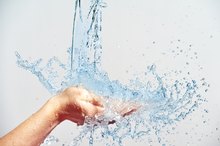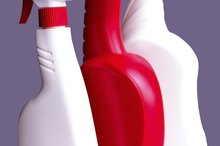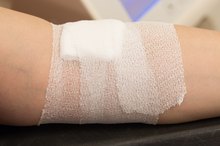What does fact checked mean?
At Healthfully, we strive to deliver objective content that is accurate and up-to-date. Our team periodically reviews articles in order to ensure content quality. The sources cited below consist of evidence from peer-reviewed journals, prominent medical organizations, academic associations, and government data.
- National Institutes of Health: Eye Emergencies
- National Institutes of Health: Chemical Burn or Reaction
The information contained on this site is for informational purposes only, and should not be used as a substitute for the advice of a professional health care provider. Please check with the appropriate physician regarding health questions and concerns. Although we strive to deliver accurate and up-to-date information, no guarantee to that effect is made.
The Effects of Bleach on Skin & Eyes
Bleach is a chlorine-based chemical solution that is widely sold in grocery stores and has numerous household applications, but it can be very dangerous. In addition to the household variety, there are also several formulations of more potent industrial bleach, and their health risks are even greater. It is especially important to avoid exposing the skin or eyes to bleach when handling it, as such an exposure can cause severe tissue damage.
Skin Effects
Exposure of common household bleach to your skin is not likely to have immediate effects, especially if the bleach has been diluted with water, according to "CRC Handbook of Laboratory Safety" by A. Keith Furr 1. The longer the bleach is left on your skin, however, the more likely it is that you will begin to experience burning, itching and other types of irritation. If the bleach is left on your skin for an inordinately long period of time, it can cause pigment lightening and permanent tissue damage. Stronger industrial formulas of bleach will produce the same results, only in a shorter amount of time.
- Exposure of common household bleach to your skin is not likely to have immediate effects, especially if the bleach has been diluted with water, according to "CRC Handbook of Laboratory Safety" by A. Keith Furr 1.
Eye Effects
How to Wash Bleach Off of Your Skin
Learn More
Getting bleach in your eyes is much more serious than getting it on your skin; damage can occur much faster, and the worst-case scenario can be more debilitating. According to Furr, pain and irritation will be immediate and proportional to the potency of the bleach. Irritation and damage to your eye tissues will continue until all of the bleach has been rinsed away, and pain and tenderness is likely to continue for hours afterward, even in cases of mild bleach exposure. If first aid is administered immediately, permanent damage may be avoided. If bleach is left to linger or if the bleach is very potent, more serious consequences can include vision damage and even loss of the eye or eyes.
- Getting bleach in your eyes is much more serious than getting it on your skin; damage can occur much faster, and the worst-case scenario can be more debilitating.
- Irritation and damage to your eye tissues will continue until all of the bleach has been rinsed away, and pain and tenderness is likely to continue for hours afterward, even in cases of mild bleach exposure.
First Aid
The immediate application of first aid is essential to minimizing skin and eye damage. The Clorox Company, makers of Clorox Bleach, recommend addressing skin exposure by washing the skin with water for 15 to 20 minutes 2. If you get bleach on clothing and it soaks through to your skin, remove the clothing first before rinsing. If no irritation develops, professional medical treatment is not necessary. If you get bleach in your eyes, hold your eyes open and flush them with clean water for 15 to 20 minutes. If you're wearing contact lenses, stop to remove them after about five minutes of rinsing, then continue. Always seek professional medical attention as quickly as possible after eye exposure. Immediate rinsing is the highest priority, but if you can get someone to summon medical attention for you while you're rinsing, do so.
- The immediate application of first aid is essential to minimizing skin and eye damage.
- The Clorox Company, makers of Clorox Bleach, recommend addressing skin exposure by washing the skin with water for 15 to 20 minutes 2.
Prevention
Home Remedies for Minor Chemical Burns
Learn More
To prevent exposure of these types, Furr recommends wearing impervious rubber gloves and safety goggles.
Related Articles
References
- "CRC Handbook of Laboratory Safety"; A. Keith Furr; 2000
- The Clorox Company: Clorox Regular Bleach MSDS
- National Institutes of Health: Eye Emergencies
- National Institutes of Health: Chemical Burn or Reaction
- "American Medical Association Handbook of First Aid and Emergency Care"; American Medical Association; 2009
- Benzoni T, Hatcher JD. Bleach Toxicity. In: StatPearls [Internet]. 2019.
- Benzoni T, Hatcher JD. Bleach Toxicity. In: StatPearls [Internet]. 2019.
- Center for Disease Control and Prevention. Cleaning and sanitizing with bleach after an emergency. Health and Safety Concerns for All Disasters. 2017.
- Centers for Disease Control and Prevention. Infection Control: Chemical disinfectants. Updated September 18, 2016.
- Centers for Disease Control and Prevention. Cleaning and Sanitizing With Bleach After an Emergency.
- E. Rhinehart, M. Friedman, and M. McGoldrick. Infection Control in Home Care and Hospice. 2006. Association for Professionals in Infection Control and Epidemiology. Jones and Bartlett Publishers.









